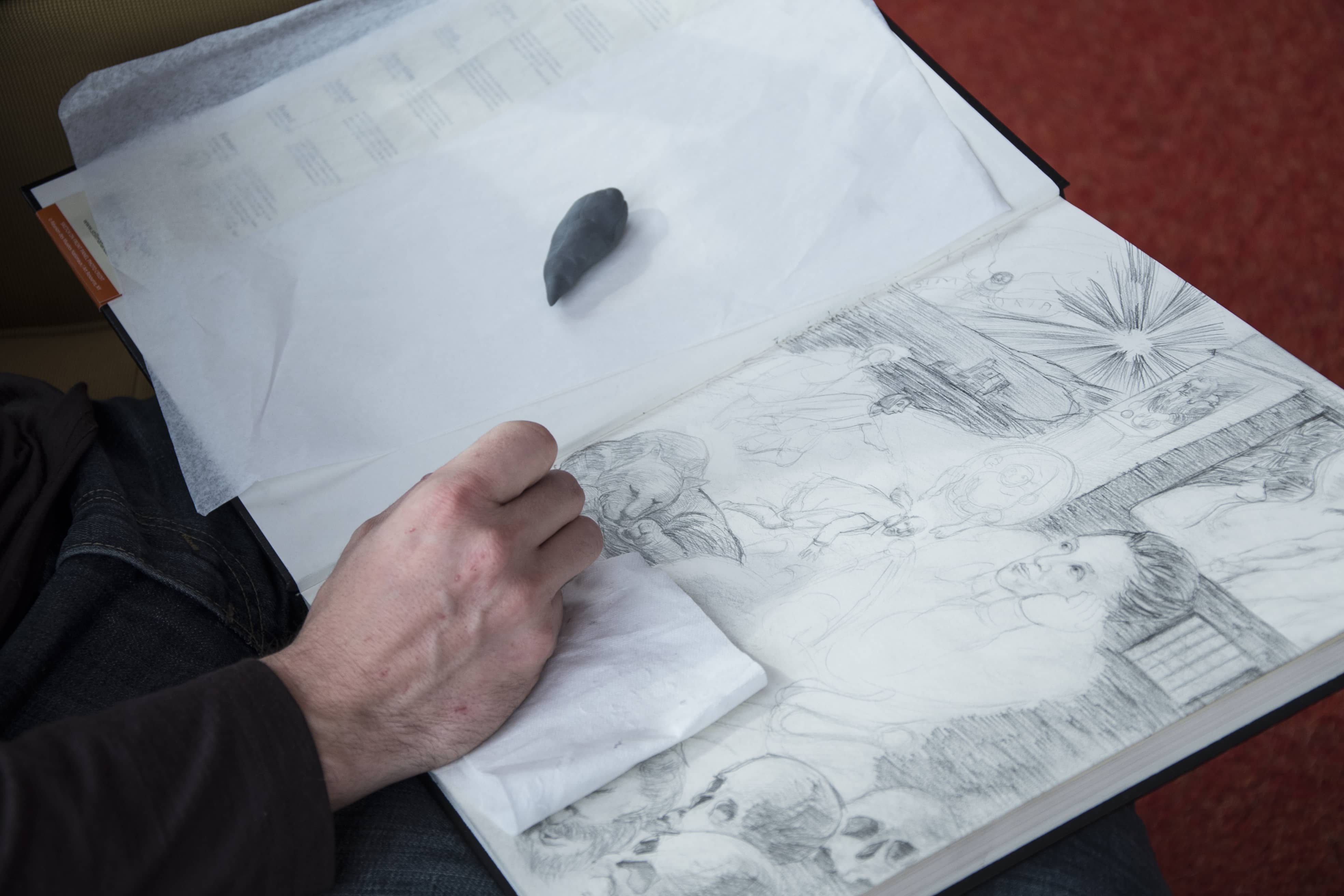His fingers blackened by the dust of sharpened graphite, the artist puts pencil to paper.
The sketchpad offers both a warm invitation and a daunting challenge. The artist knows many hours, days, weeks, even months may pass before the blank page in front of him will convey the rich narrative he has envisioned for it.
There is so much he wants to say – a tale told in shapes and shades rather than words – about science, about art, and about the ways they collide and coalesce in humankind’s ongoing search for understanding.
He knows it will not be easy.
“The convergence of art and science is not peaceful,” says the artist. “There is a tension between them, and this tension cannot be resolved. Any resolution would make them dead. Peace is a beautiful thing, but not in the world of ideas. Ideas are alive when they fight.”
 Alioscia Hamma feels this tension – invites it – every day. Barely an hour before he opened the sketchpad and sharpened his pencils, he delivered a lecture called “Geometry of quantum phase transitions” to a class of graduate students at Perimeter Institute.
Alioscia Hamma feels this tension – invites it – every day. Barely an hour before he opened the sketchpad and sharpened his pencils, he delivered a lecture called “Geometry of quantum phase transitions” to a class of graduate students at Perimeter Institute.
In his professional life, Hamma is a lecturer in the Perimeter Scholars International (PSI) program and an Associate Professor at China’s Tsinghua University. His research seeks new insights into quantum entanglement, quantum statistical mechanics, and other aspects of the fundamental nature of reality.
He examines reality from a different perspective at moments like this, when he sets his mind and his pencil to a truly blank canvas in pursuit of insights that science alone cannot unveil.
Though he dreamed during his boyhood in Naples of one day becoming a comic book artist, he pursued physics because he believed – still believes – it is our most reliable tool for decoding our universe.
“Mathematics is ideal, clean, pure, and meaningless. Natural sciences are living, concrete, dirty, and meaningful. Physics is right in the middle, like the human condition,” says Hamma.
Art too, he says, resides in the middle ground between the world of ideals and the world as it presents itself to our senses.
 So he draws. As his pencil scratches across the paper, lines become shapes. Shapes assume dimension, depth, character. A central figure emerges – German mathematician Emmy Noether – her head resting wearily on her hand, eyes fixed on some distant point. To her right lies a sleeping tiger, its “fearful symmetry” an homage to both Noether’s famous theorem and to poet William Blake.
So he draws. As his pencil scratches across the paper, lines become shapes. Shapes assume dimension, depth, character. A central figure emerges – German mathematician Emmy Noether – her head resting wearily on her hand, eyes fixed on some distant point. To her right lies a sleeping tiger, its “fearful symmetry” an homage to both Noether’s famous theorem and to poet William Blake.
As the drawing takes shape over the weeks that follow, more allusions to art and science emerge – allusions to early Renaissance woodcuts and paintings, allusions to the Copernican revolution and to mathematical perfection.
Hamma is reluctant to elaborate on these visual metaphors or their intended meanings. He hopes the artwork will be for its viewers a kind of “treasure hunt” about symmetry in art and physics.
“If I need to explain it,” he says, “it means, in some sense, I have failed.”
Hamma believes easy answers rarely provide true insight.
His artwork, like his research, is rewarding in part because it is difficult. This particular drawing will consume much of his spare time over the weeks that follow. He takes it back to China with him when his teaching term at Perimeter is complete, revisiting it when his restless mind seeks a different form of expression than physics.
One day – perhaps tomorrow, perhaps years from now – he will make one final stroke of the pencil and this piece will be finished. Then, he will flip the page of the sketchpad and begin a new piece, exploring other ideas and challenging himself to think differently.
Finishing the drawing was never the point. The act of creation is its own raison d’être.
“I do not see art and science as separate,” he says. “For me, understanding the shape of an object, or a poem, a chapter of human history, a biological organism, or a physical system – these are all beautiful things to do.”
– Colin Hunter
More Bites of Pi:
About PI
Perimeter Institute is the world’s largest research hub devoted to theoretical physics. The independent Institute was founded in 1999 to foster breakthroughs in the fundamental understanding of our universe, from the smallest particles to the entire cosmos. Research at Perimeter is motivated by the understanding that fundamental science advances human knowledge and catalyzes innovation, and that today’s theoretical physics is tomorrow’s technology. Located in the Region of Waterloo, the not-for-profit Institute is a unique public-private endeavour, including the Governments of Ontario and Canada, that enables cutting-edge research, trains the next generation of scientific pioneers, and shares the power of physics through award-winning educational outreach and public engagement.
You might be interested in



